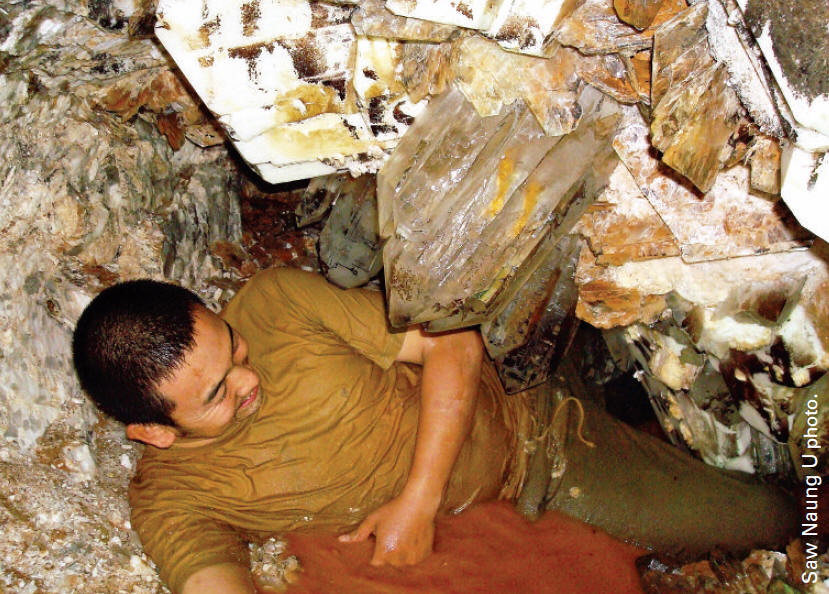
Huge quartz crystals in the big pocket in Sakangyi mine, Myanmar.
The Mogok region in Myanmar hasbeen one of the world's most famous andimportant gem and mineral-producingareas for centuries. The mines producingrubies and spinels from marblesare especially well known to collectors.
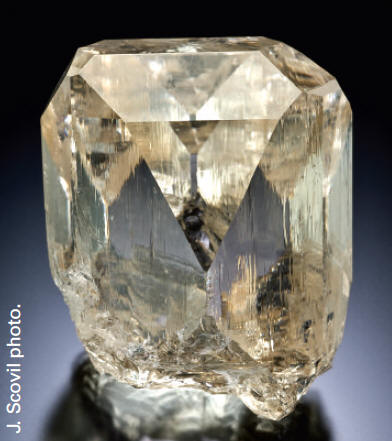
Gem topaz from the Sakangyi mine, Myanmar;5.1 cm high. M. Zinn collection.
The Sakangyi mines, operating in pegmatites,are much less familiar: apartfrom a very few articles published ingemological magazines they have gonealmost entirely undescribed.
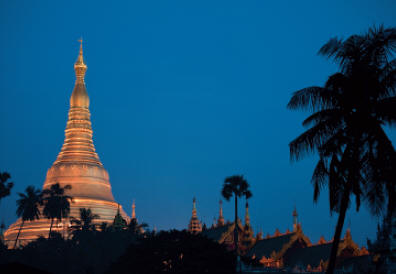
Famous Buddhist temple: the Shwedagon Pagoda, Yangon, Myanmar. Photo M. Mauthner, courtesy Pala International.
Probablythe most important reason for that fact is that the Mogok area has been closedto foreigners for years, but now that politicalchanges are starting in Myanmar,there is a chance that the Sakangyi areawill be re-opened in the near future. Anadditional problem with Sakangyi specimensis that the vast majority of themare sold to Chinese dealers and laterresold as Chinese specimens.
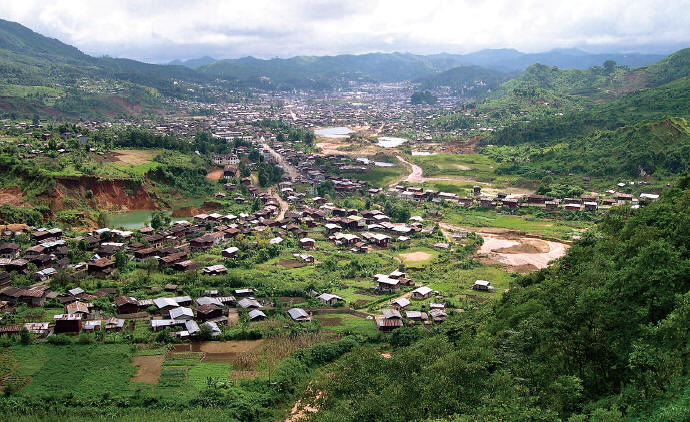
Mogok town – capital of gemstones and minerals of Myanmar. F. Bärlocher photo.
The Sakangyi mines are the sourceof some of the world's best topaz crystals, and they produce incredible combinationsof topaz with huge, clear quartzcrystals, feldspars and mica. Spectacularspecimens of aquamarine crystalsare also known from the locality.
At the end of 2006 a huge pocketfilled with incredible crystals was foundin one of the Sakangyi mines. Thanks tothe mine owner, Saw Naung U, the mudwas washed out and the pocket was photographedbefore specimens were extracted!
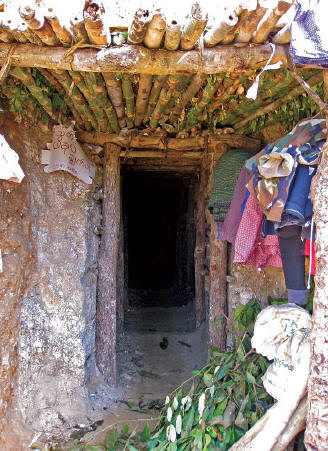
Entrance to the mine in Sakangyi. F. Bärlocher and Win Htin photo.
This is probably the only pocketever photographed in this area. Becauseof the exceptional size and quality of thespecimens, and because the find was so well documented, the pocket is worthspecial attention.
SAKANGYI PEGMATITESSakangyi is located in the MogokMetamorphic Belt (MMB) in front of theHimalaya collision zone. This belt wasformed in the Alpine orogeny, which wasa result of the collision between theIndian and Asian plates. The main geologicalconsequence of this massive collisionwas the formation of the Himalayachain of mountains.
The MMB is a huge elongated structurestretching North-South along thewhole of Myanmar, it is over 1500 kmlong and 22-40 km wide. The MMB washeavily injected by post-orogenic magmaticintrusions, mainly of granitic type.
In the later stages of its geological evolutionthe MMB was uplifted and exposedin its present form.
Sakangyi is located in the areawhere one of the intrusive bodies – theKabaing Granite, composed of gray biotitemicrogranite – crops out. The age of this intrusion is estimated at 15-20 my,i.e. Miocene. The age of the pegmaties isvery similar to the age of the granites, somost probably the pegmatites' formationwas a direct result of late magmaticprocesses. Pegmatitic bodies are locatedclose to the edge of intrusion, and theirchemistry strongly implies that contaminationprocesses where they contactedmetamorphic rocks, such as marbles,played an important role in their formation.
The pegmatites are lenticular inshape, up to a few meters wide and significantlyelongated - to a few dozen meterslong. The temperature of theirformation has been determined as 500-650°C. They are classified as REE beryltypepegmatites.
The Sakangyi pegmatites have beenthe source of gemstones, and less frequentlyof specimens, for over 100 years.
Gemstones are mined either directlyfrom the weathered pegmaitites or fromcolluvial/alluvial deposits. Specimenscome from excavations made directly inthe pegmatite bodies.
LOCALITY AND MINESThe Sakangyi mines are located inthe Mogok Valley, approximately half anhour‘s walk from the main asphalt roadlinking Mogok and Mandalay towns, 16km west of Mogok.
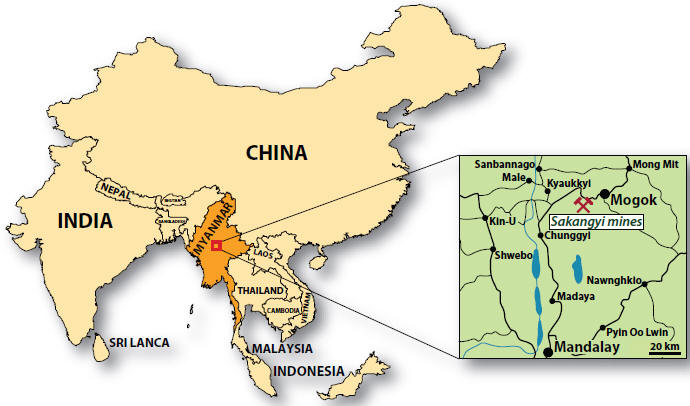
Map of part of Asia showing Myanmar; the insert shows the location of the Mogok and the Sakangyi mines.
There are currently seven smallmines operating in the Sakangyi miningcamp. The majority of them are just simpletunnels or shafts a few dozen meters long. The mines operate in the biggerpegmatite bodies, particularly in theircores, where pockets are usually located.
Because the pegmatites are partlyweathered and kaolinized, mining isquite easy.
The most intensive production inSakangyi took place in 1990’s and 2000’s.
Recent production has been muchslower and has focused on gemstonesfrom the alluvial/colluvial deposits.
The most intensive mining in thearea is done in the dry season – fromSeptember to March.
The majority of specimens andgems are transported to the border town of Ruili, where they are sold to Chinesedealers.
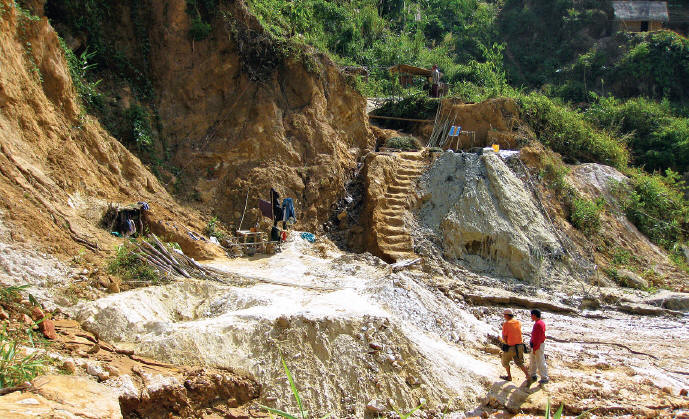
Workings at Sakangyi, entrance to the main mine at the left. F. Bärlocher, Win Htin photo.
MINERALS
The mineral species from Sakangyiwhich are of most interest to collectorsare described below. Because knowledgeof these pegmatites is limited, and no seriousmineralogical analyses have yetbeen done, the complete list of mineralsfrom the pegmatites is certainly longerthan the one given here.
BerylBesides topaz, beryl is the most importantgem mineral mined in theSakangyi area. It occurs in a wide varietyof aquamarine colors – from deepblue through light blue and greenishblue, and much more rarely as pinkishmorganite zones. The crystals aremostly translucent, but many are entirelygemmy. Their form is typical foraquamarine: hexagonal, prismatic andelongated, with simple pinacoidal terminationsand minor pyramid faces. Sometimesthe crystal faces are deeply etched,and crystals of this type usually havecomplex terminations.
The beryl crystals commonly reach10 cm in length, but specimens over 20cm are known. The vast majority of thecrystals are found loose, and sometimesthey are doubly terminated.
Specimenson matrix or clusters are much more difficultto find.
The gemstone industry is the mostimportant consumer of beryls; however,well formed crystals are usually preservedand sold as mineral specimens.
The biggest cut stones made fromSakangyi beryls weigh a few hundredcarats!

25 m deep shaft in Sakangyi. F. Bärlocher and Win Htin photo.
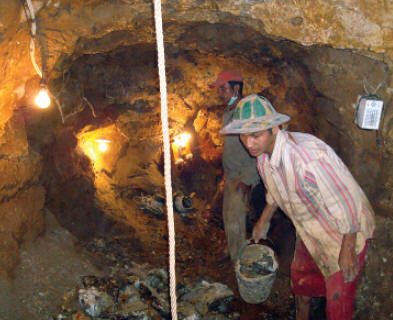
Miners working in the mine.Saw Naung U photo.











 YueGongAnBei 44051102000467
YueGongAnBei 44051102000467


 |
|